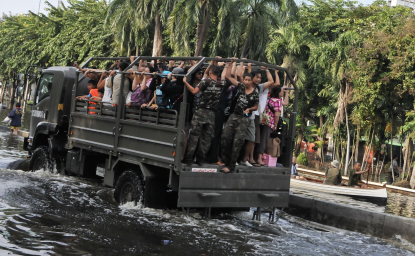Q: How will climate change influence global financial stability?
Shortly before the COVID-19 pandemic, Secretary-General António Guterres said climate disruption poses a serious and growing threat to the world’s short- and long-term economic prospects, adding, “That is why I will continue to push to keep the climate crisis at the top of the international agenda.”
The rising emissions and increasing greenhouse gas concentrations that we saw through the end of 2019 provide the potential for catastrophic outcomes that warrant urgent policy actions. Putting policy instruments and market adjustments in place to bring about a dramatic reduction in CO2 emissions is an urgent priority.
The economic predictions for 2020, issued this January, did not foresee a good year ahead—and those forecasts preceded the human and economic calamity that is still unfolding due to COVID-19. But had we heeded the warning signals, perhaps the scope of the pandemic’s damage—in terms of lives lost and livelihoods destroyed—could have been less.
The Secretary-General recently told ministers, “I am not here today to tell you that everything will be OK. We need to be honest with ourselves. The COVID-19 crisis is having devastating impacts because of our past and present failures.”
The failures, he said, include not taking the Sustainable Development Goals seriously enough, not heeding warnings about the damage we are inflicting on our natural environment, and taking risks with climate disruption. “We put up with inequalities within and between countries that have left billions of people just one crisis away from poverty and financial ruin. We have not invested adequately in resilience – in universal health coverage; quality education; social protection; safe water and sanitation. We have yet to right the power imbalances that leave women and girls to constantly bear the brunt of any crisis.”
There has been a surge in interest from companies in adopting sustainable business plans that are compatible with a 1.5°C future, yet with a few notable exceptions, markets and major financial institutions have yet to take climate change seriously. Major pensions funds and investments firms acknowledge that their portfolios are more aligned with a 3.5°C future.
Many investors continue to underestimate the risks of climate change and are still making short-sighted decisions to expand investment into carbon-intensive assets. One of the primary ways to break the link between greenhouse gas emissions and economic activity is to change the energy supply mix, transitioning from fossil fuels to renewable sources of energy.
This transition will require policies that steer nations towards carbon neutrality well before 2050. The Secretary-General has set six priority areas for climate action during the COVID-19 recovery phase including: investing in decent jobs; no bail-outs for polluting companies; abandoning perverse fossil fuel subsidies; ending investment in and construction of coal-fired power plants by 2020; taking climate risks and opportunities into account in all financial and policy decisions; increasing international cooperation; and ensuring a just transition that leaves nobody behind.
And if we don’t? We ignore these risks at our peril. Rising sea level and energy consumption will require major infrastructure investments in cities, but will cities continue to be able to raise money from municipal bonds? Will home mortgages still be available if lenders can’t estimate the impact of climate risk over such a long timeline, and if there is no viable market for flood or fire insurance in impacted areas? What happens to inflation, and in turn interest rates, if the cost of food climbs from drought and flooding? How can we model economic growth if emerging markets see their productivity decline due to extreme heat and other climate impacts?
Q: What steps can the foreign policy community take to address climate-related risks in this area?
In 2015 the world came together to adopt the Paris Agreement on climate change and the Sustainable Development Goals. We are not on track to achieve the goals of either.
International cooperation is fundamental to addressing climate change as it is truly a challenge that affects all countries—and no country can solve it on its own. Progress in one place can easily be offset by increased emissions in another.
But while some countries and companies have gotten the message that climate concerns must be part of their COVID-19 recovery plans, many have not. Recent reports show that in major emitting countries, recovery stimulus packages are spending twice as much on fossil fuels than on clean energy sources.
Implementation of the Paris Agreement requires full transparency and international cooperation. Developing countries require assistance to enable them to decarbonize their economies with clean, renewable energy, and to help build adaptation and resilience against a problem that is not of their making.
National action needs to be mirrored by actions abroad. Phasing out coal domestically is necessary and essential, but countries can’t stop there—they must also stop funding of coal abroad and actively offer funding for renewables instead.
Governments need to show that they are serious about honoring their national contributions under the Paris Agreement; they need to substantially increase their ambitions under their Nationally Determined Contributions. They also need to show that they are ready to meet their obligations under the Paris Agreement to ramp up financial support to developing countries.
Q: What role should central banks play in combating the climate crisis, and is there a need to adjust their mandate or the powers they possess?
For the role of central banks, I look to UN Special Envoy on Climate Finance Mark Carney, who, until recently, was the Governor of the Bank of England. According to Mr. Carney, a new and sustainable financial system is slowly, yet surely, being built that will provide funding for the initiatives and innovations of the private sector, which in turn has the potential to amplify the effectiveness of the climate policies of governments.
“But the task is large, the window of opportunity is short, and the risks are existential,” he said, adding that “like virtually everything else in the response to climate change, the development of this new sustainable finance is not moving fast enough for the world to reach net zero.”
There are several key points that Mr. Carney makes about changing the financial landscape to fully bring climate risks and resilience into the heart of financial decision-making.
First, climate disclosure must become comprehensive, climate risk management must be transformed, and sustainable investing must go mainstream, using the framework provided by the Task Force on Climate-related Financial Disclosures—a comprehensive, practical and flexible framework for corporate disclosure of climate-related risks and opportunities.
Second, make these disclosures mandatory everywhere. “It’s time for every country to get involved because the world won’t get to net zero if the financial sector doesn’t know how our companies are responding,” said Mr. Carney. “In order to watch we must be able to see.”
In addition, the providers of capital—banks, insurers, asset managers—and those who supervise them all need to improve their understanding and management of climate-related financial risks. The changes in climate policies, new technologies, and growing physical risks will prompt reassessments of the values of virtually every financial asset, and firms that align their business models to the transition to a net zero world will be rewarded handsomely—while that those that fail to adapt will cease to exist.
Finally, financial markets increasingly recognize that sustainable investment is the new horizon that can bring enormous opportunities. To go mainstream, Mr. Carney said that sustainable investing must cover, catalyze, and support “all companies that are working to transition from brown to green.”
Q: How prepared is the financial system for regulatory shock and large investments becoming stranded assets—and what do regulators need to do to shore up the system?
It is increasingly clear that the world cannot afford to burn all of its fossil fuel reserves if we are to succeed in limiting climate change to sustainable, livable, levels. This raises the question of assets that will be abandoned well before their intended date of retirement and will not produce the expected returns. Already, coal mines are being closed as the price of coal becomes increasingly more expensive compared with renewable energy sources.
Losses due to stranded assets can imperil financial stability. According to Mr. Carney, a stress test is needed, and it is necessary to build a large coalition of central banks and supervisors to conduct these tests. “The Bank of England will become the first regulator to stress test its major banks and insurers against different climate pathways, including the catastrophic business–as-usual scenario,” said Mr. Carney. “Our stress test of the world’s leading international financial centre will show how major financial firms expect to adjust their business models, and what the collective impact of these responses could be on the wider economy.”
If estimates are even approximately correct, he said, “it would render the vast majority of reserves ‘stranded’ – oil, gas and coal that will be literally unburnable without expensive carbon capture technology, which itself alters fossil fuel economics.”
Q: What is the role of insurance providers and regulators for setting price signals and helping to advance the transition to a more sustainable economy?
The insurance sector can supply expertise, money, and perspective that are crucial in helping society adjust to the reality of a transition to a sustainable economy. The sector, with assets over US$30 trillion, can help make decisive contributions to reduce the protection gap, financing resilient infrastructure or improving reporting, risk management, and return optimization across the financial sector.
Insurers understand the physical risks of climate change that are being felt across the globe; insured losses in 2018 were US$80 billion, double the inflation-adjusted average for the past 30 years.
In low and middle income countries, a lack of protection means that even greater costs are being borne by the uninsured. In 2017, the record US$140 billion of insured losses was eclipsed by an additional US$200 billion of uninsured losses.
According to Mr. Carney, both sides of insurers’ balance sheets need to respond. On the liability side, the focus must be reducing the protection gap and supporting the resilience of households and companies to growing climate risks. And on the asset side, infrastructure investments will be essential. To transition to net zero, all countries need to step up their investments in sustainable energy. The reality of climate change also means that all countries, but particularly developing and emerging economies, will need to invest in new climate-resilient infrastructure in order to adapt to the new realities of a hotter and more volatile climate.
Author

Environmental Change and Security Program
The Environmental Change and Security Program (ECSP) explores the connections between environmental change, health, and population dynamics and their links to conflict, human insecurity, and foreign policy. Read more

Explore More
Browse Insights & Analysis
Can Climate-Resilient Agriculture Become an Engine for Syria’s Post-Conflict Recovery?

ECSP Weekly Watch | March 10 – 14

ECSP Weekly Watch | February 17 – 21



